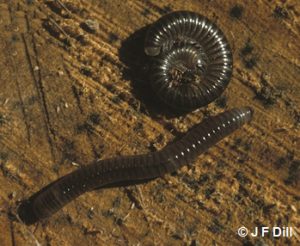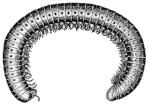Millipedes
Pest Management Fact Sheet #5029
James F. Dill, Pest Management Specialist
Clay A. Kirby, Insect Diagnostician
For information about UMaine Extension programs and resources, visit extension.umaine.edu.
Find more of our publications and books at extension.umaine.edu/publications/.
Description & Biology
Millipedes usually go unnoticed in the summer because of their nocturnal habits and tendency to disperse. The common species are found in dark, damp, and cool places. They feed almost entirely on decomposing organic matter, which would seem to make them beneficial to the environment. However, for many people, they can become a nuisance in and around homes.
Maine’s common millipedes (which are diplopods, not insects) are up to 3/16″ thick and up to 1¼” long. The body of a millipede has many segments, with two pairs of legs on each segment.
- Millipede on a potato
Water-saturated soil forces millipedes to the surface in search of drier ground. In the fall, they also search for better over-wintering sites. When one or both of these conditions exist (i.e. during wet, fall weather), it is common for large numbers of millipedes to be found in garages, and to a lesser extent, in basements.
Management
Sanitation is the most important factor in suppressing populations of millipedes. One’s goal needs to be to deprive the creatures of their habitat. As when dealing with slugs, earwigs, sowbugs and the like, never give millipedes a place to hide. Any kind of debris or decomposing organic matter is likely to attract millipedes. Even mulch can become a good habitat. You should also locate gaps in doors and other household entry points, then incorporate barriers such as door sweeps to plug the gaps.
If an unbearable amount of millipedes are getting into the house, application of a residual pesticide may be warranted. Outside, spot treatments around areas where millipedes are gaining entry may help. Materials that can be used in this way (and also as band treatments of synthetic pyrethroids) include: permethrin, bifenthrin, deltamethrin, and cyfluthrin or Sevin (carbaryl). If millipedes are getting in through cracks and crevices in the foundation, these can also be treated.
Once millipedes find their way indoors (typically a garage and/or cellar), they usually do not live very long. For this reason, we suggest that you just sweep them up and dispose of them, rather than using a pesticide.
When Using Pesticides
ALWAYS FOLLOW LABEL DIRECTIONS!
Pest Management Unit
Cooperative Extension Diagnostic and Research Laboratory
17 Godfrey Drive, Orono, ME 04473
1.800.287.0279 (in Maine)
Information in this publication is provided purely for educational purposes. No responsibility is assumed for any problems associated with the use of products or services mentioned. No endorsement of products or companies is intended, nor is criticism of unnamed products or companies implied.
© 2016, 2018, 2020 | Reviewed: 2023
Call 800.287.0274 (in Maine), or 207.581.3188, for information on publications and program offerings from University of Maine Cooperative Extension, or visit extension.umaine.edu.
In complying with the letter and spirit of applicable laws and pursuing its own goals of diversity, the University of Maine System does not discriminate on the grounds of race, color, religion, sex, sexual orientation, transgender status, gender, gender identity or expression, ethnicity, national origin, citizenship status, familial status, ancestry, age, disability physical or mental, genetic information, or veterans or military status in employment, education, and all other programs and activities. The University provides reasonable accommodations to qualified individuals with disabilities upon request. The following person has been designated to handle inquiries regarding non-discrimination policies: Director of Equal Opportunity, 101 Boudreau Hall, University of Maine, Orono, ME 04469-5754, 207.581.1226, TTY 711 (Maine Relay System).




